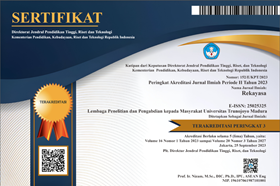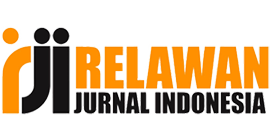The Use of Padlet in Writing Learning Reflection: Students’ Perspectives
Abstract
Digital learning media is indeed developing and plays an important role in creating a pleasant learning environment that can accommodate students' learning needs. Padlet provides space for students to learn digitally, especially through the activity of writing learning reflections. This research is aimed at finding out students' perspectives on the use of Padlet media to write reflection activities. This study was attended by 50 students in the seventh grade using a qualitative research method in the form of phenomenology design. Data was obtained from questionnaires distributed via Google Form, observations, and interviews. The data obtained from the Google Form is strengthened by conducting interviews, where the purpose of the interviews is to check the consistency of the Google Form results. The finding revealed that students gave positive responses regarding Padlet media. They perceived that Padlet media was easy to use, helped the students to discuss developing ideas and exchange ideas, eliminated boredom, increased the students’ participation in writing reflections, and increased students’ learning motivation. It is concluded that Padlet can serve as an effective digital tool to support reflective learning. Future studies are suggested to investigate Padlet's effectiveness in comparison with other digital platforms or in different educational contexts.
Keywords
References
Algraini, F,N,A. (2014). The Effect of Using Padlet on Enhancing EFL Writing Performance. Arab World English Journal Theses / Dissertation.
Apriliana, A. (2022). Penggunaan Media Padlet Untuk Meningkatkan Keterampilan Menulis Puisi Pada Siswa Smp Islam Al Kautsar. Jurnal Impresi Indonesia, 1(6), 594–603. https://doi.org/10.58344/jii.v1i6.76
Asrori. 2020. Psikologi pendidikan pendekatan multidisipliner. Jawa Tengah: CV Pena Perada.
Badriah. 2021. Padlet sebagai alternatif papan tulis sinkronus maya. Simpul Juara, 16–23.
Budi, R. 2022. Pemanfaatan media pembelajaran digital padlet sebagai solusi pembelajaran di masa pandemi Covid-19. Educenter : Jurnal Ilmiah Pendidikan Vol 1 No 5 Mei 2022.
Creswell, J. W. 2012. Educational Research: Planning, Conducting, and Evaluating Quantitative and Qualitative Research (4th ed). Pearson Education, Inc.
England, S. (2017). Tech for the modern EFL student: collaborate and motivate with Padlet. Accents Asia, 9(2), 56–60. http://www.issues.accentsasia.org/issues/9-2/England.pdf. 9, 56–60.
Fadhilawati, D. (2020). Using Padlet to Increase the Students’ Procedure Text Writing Achievement. Exposure: Jurnal Pendidikan Bahasa Inggris, 9(2), 158-172.
Freankel, J. R., Wallen, N. E., & Hyun, H. H. (2012). How to
design and evaluate research in education. McGraw Hill
Hakim, B. (2021). Role of ICT in the process of EFL teaching and learning in an Arab context. Humanities and Social Sciences Letters, 9(1), 58–71. https://doi.org/10.18488/JOURNAL.73.2021.91.58.71
Hammond, H. G., & Waltemeyer, S. (2021). Policies and procedures that may hinder morale, motivation, and engagement. In Handbook of research on inclusive development for remote adjunct faculty in higher education (pp. 233–252). IGI Global Scientific Publishing.
Haris, M., Yunus, M. M., & Badusah, J. H. (2017). The effectiveness of using Padlet in ESL classroom. International Journal of Advanced Research, 5(2), 783–788.
Ismayanti, I., Arsyad, M., & Marisda, D. H. (2020). Penerapan Strategi Refleksi Pada Akhir Pembelajaran Untuk Meningkatkan Keterampilan Berpikir Kreatif Peserta Didik Pada Materi Fluida. Karst : JURNAL PENDIDIKAN FISIKA DAN TERAPANNYA, 3(1), 117–121. https://doi.org/10.46918/karst.v3i1.573
ISTE Standards. 2019. https://padlet.com/ckaplan3/doj-techfest-2019-iste-standards-3cyah6h59cy0. Retrived on May 22nd 2024.
Lucas, G., Cao, G., & Waltemeyer, S. (2021). The Value of Instructor Interactivity in the Online Classroom. Journal on Empowering Teaching Excellence, 5(1 Journal on Empowering Teaching), 3–28. https://digitalcommons.usu.edu/jete/vol5/iss1/3/
Miles and Hubermen. 2014. Qualitative data Analysis. Arizona State University. Third Edition.
Nana, N., & Surahman, E. (2019). Pengembangan Inovasi Pembelajaran Digital Menggunakan Model Blended POE2WE di Era Revolusi Industri 4.0. Prosiding SNFA (Seminar Nasional Fisika Dan Aplikasinya), 4, 82. https://doi.org/10.20961/prosidingsnfa.v4i0.35915
Nashir, M. & Laili, R. N. (2021). Hybrid learning as an effective learning solution on intensive English program in the normal era. Journal of Language Teaching and Learning, Linguistics and Literature IDEAS, 9(2), 220-232. DOI: 10.24256/ideas.v912.2253
Nofrion. (2021). Padlet sebagai Platform Pembelajaran Daring pada Masa Pandemi (Sebuah Panduan Sederhana). Journal Buana, 1–8. https://osf.io/preprints/osf/7ehg4
Qulub, T., & Renhoat, S. F. (2020). Penggunaan media padlet untuk meningkatkan keterampilan menulis teks deskripsi. Prosiding Samasta.
Rofiah, N. L., Sha’ar, M. Y. M. A., & Waluyo, B. (2023). The efficacy of integrating Padlet-mediated feedback into writing lessons: A case of lowproficiency Students. JALT CALL Journal, 19(3), 317–343. https://doi.org/10.29140/JALTCALL.V19N3.1150
Sitepu, E. N. (2021). Media Pembelajaran Berbasis Digital. Mahesa, 1(1), 242–248. https://doi.org/10.34007/ppd.v1i1.195
DOI
https://doi.org/10.21107/rekayasa.v18i2.30977Metrics
Refbacks
- There are currently no refbacks.
Copyright (c) 2025 Fadhika Kurniati, Dzulfikri Dzulfikri, Adi Bandono

This work is licensed under a Creative Commons Attribution-ShareAlike 4.0 International License.
























